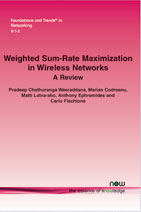Weighted Sum-Rate Maximization in Wireless Networks: A Review
By Pradeep Chathuranga Weeraddana, Automatic Control Lab, KTH Royal Institute of Technology, Sweden, chatw@kth.se | Marian Codreanu, Centre for Wireless Communications, University of Oulu, Finland, codreanu@ee.oulu.fi | Matti Latva-aho, Centre for Wireless Communications, University of Oulu, Finland, matti.latva-aho@ee.oulu.fi | Anthony Ephremides, University of Maryland, College Park, USA, etony@ece.umd.edu | Carlo Fischione, Automatic Control Lab, KTH Royal Institute of Technology, Sweden, carlofi@kth.se
Abstract
A wide variety of resource management problems of recent interest, including power/rate control, link scheduling, cross-layer control, network utility maximization, beamformer design of multiple-input multiple-output networks, and many others are directly or indirectly reliant on the weighted sum-rate maximization (WSRMax) problem. In general, this problem is very difficult to solve and is NP-hard. In this review, we provide a cohesive discussion of the existing solution methods associated with the WSRMax problem, including global, fast local, as well as decentralized methods. We also discuss in depth the applications of general optimization techniques, such as branch and bound methods, homotopy methods, complementary geometric programming, primal decomposition methods, subgradient methods, and sequential approximation strategies, in order to develop algorithms for the WSRMax problem. We show, through a number of numerical examples, the applicability of these algorithms in various application domains.
Weighted Sum-Rate Maximization in Wireless Networks
The weighted sum-rate maximization (WSRMax) problem plays a central role in many network control and optimization methods, such as power control, link scheduling, cross-layer control, network utility maximization. The problem is NP-hard in general. In Weighted Sum-Rate Maximization in Wireless Networks: A Review, a cohesive discussion of the existing solution methods associated with the WSRMax problem, including global, fast local, as well as decentralized methods is presented. In addition, general optimization approaches, such as branch and bound methods, complementary geometric programming, and decomposition methods, are discussed in depth to address the problem. Through a number of numerical examples, the applicability of the resulting algorithms in various application domains is demonstrated. The presented algorithms and the associated numerical results can be very useful for network engineers or researchers with an interest in network design.
